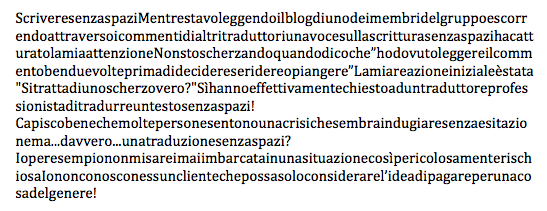 As I was reading the blog of one of the group members and scrolling through the comments of other translators, a voice on writing without spaces has caught my attention. I’m not kidding when I say that “I had to read the comment twice before deciding whether to laugh or cry.” My initial reaction was “This is a joke, right?”. Yes, they actually asked a professional translator to translate a text without spaces! I understand that many people feel a crisis that seems to linger without hesitation, but … really … a translation without spaces? I, for one, I would never have embarked on a situation so dangerously risky. I do not know any customer who may only consider the idea of paying for a thing!
As I was reading the blog of one of the group members and scrolling through the comments of other translators, a voice on writing without spaces has caught my attention. I’m not kidding when I say that “I had to read the comment twice before deciding whether to laugh or cry.” My initial reaction was “This is a joke, right?”. Yes, they actually asked a professional translator to translate a text without spaces! I understand that many people feel a crisis that seems to linger without hesitation, but … really … a translation without spaces? I, for one, I would never have embarked on a situation so dangerously risky. I do not know any customer who may only consider the idea of paying for a thing!
However, this very brave translator has decided to accept the source text and translate it into the language required without using spaces between words, articles, punctuation, etc. I must admit it was really brave to be able to do such a thing. Despite everything, I can not help but wonder whether it was “really” or not paid for this work and I would be curious to know how long the customer has had to waste to adjust and rearrange everything.
Because bloggers often take their time to respond to the comments of other people, I decided to conduct another of my little experiments to test the principle of writing with no spaces in terms of productivity and savings. I’m too curious to find out how such a thing could really work.
Whereas they asked the translator to work on a document with no spaces, I guess they did a total count of the characters (the translators use this kind of counting and take account of the spaces before fixing their rates) in the text to formulate their final estimate. If we consider my first three paragraphs, including the title of this article, we count 1,169 characters without spaces and with 1,411 spaces. In this sector, these numbers translate into 1 page of translation in both cases. For those of you who are not aware of this expression, 1 page = 1,500 characters. Each translator deliver its price for folder and anything above one (like 1.2) will be considered as a 2nd folder. Therefore, in this case, there is no difference in cost.
However, suppose that counts were 11,690 initial characters with no spaces and 14,110 spaces. So, we now 8 folders against 10 folders. Suppose that the cost was 25 Euros per folder. In this case, we can say that the client has saved 50 euro for that translation with no spaces. But, do you really think I’ve saved that amount?
This time, I will use the first paragraph and the title of this article to help you view the image clearly.
I just can not describe how I feel right now. And you? Before entering into the question of production and savings related to writing without spaces, I should mention that no translator would never be able to re-read their work. Therefore, the quality of the translation may be sacrificed. My spell-Word I dumped her and stopped to highlight any errors in grammar or spelling … not to mention the fact that the word “senzaspazi” is not recognized by the system.
However, I said that I intended to find out what it meant in terms of cost–effectiveness and are now ready to present my final evaluations.
Original document: 708 characters with spaces and 588 without spaces, which is equivalent to 1 page of text in both cases.
Time required to adjust the final document: at least 10 to 15 minutes of great frustration.
Multiply these numbers to 10: 4 folders (without spaces) instead of 5 (with spaces), 120 € instead of 125 €, plus 100-150 minutes of added stress.
All this, of course, if you have an employee who speaks the required language (Italian in this case), and who has the time to adapt the text. However, it will take at least two hours of his time. Do you still think that this kind of writing is really productive or to have saved something? Please feel free to comment if you think you‘ve made a mistake in my calculations.





